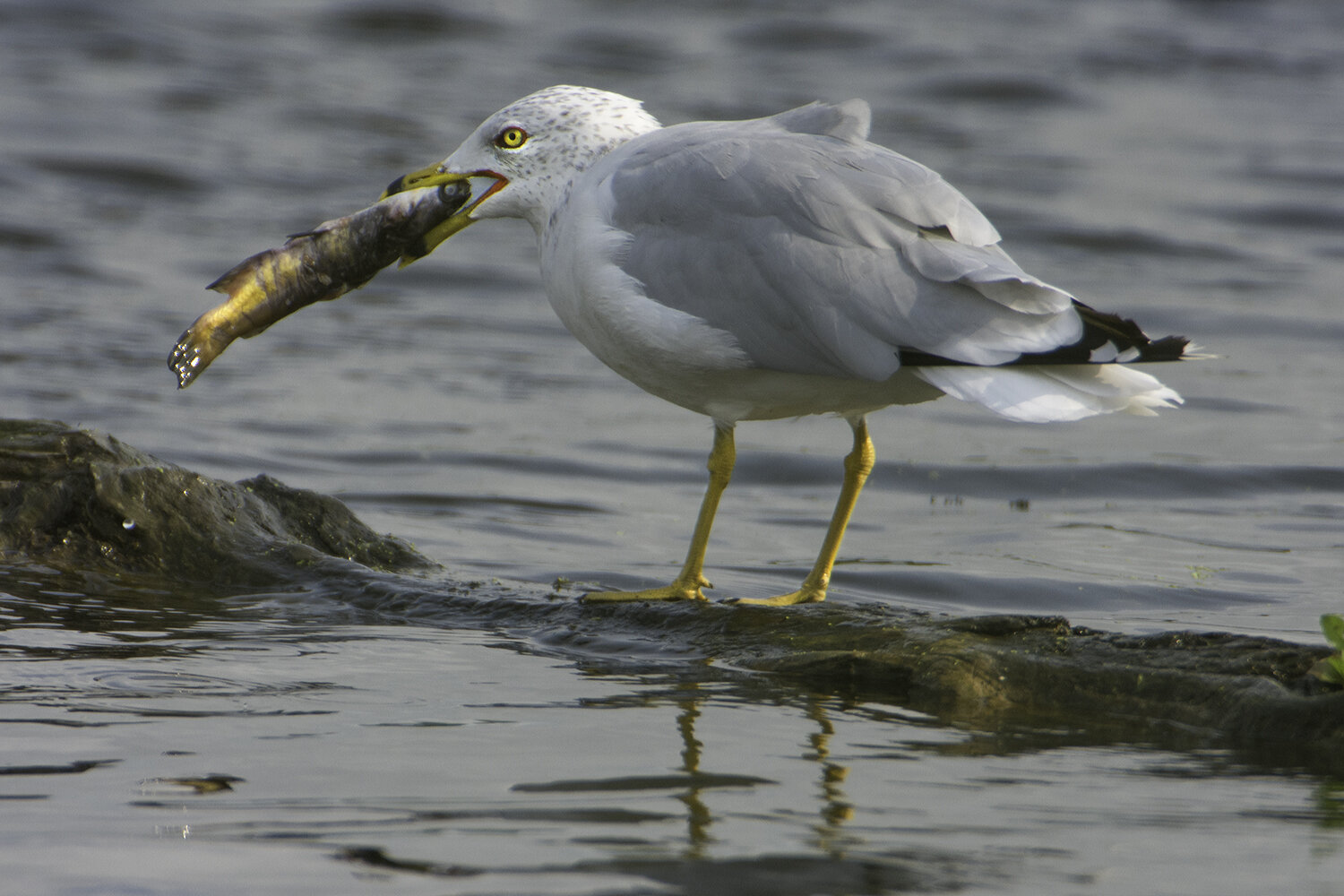Goose Pond could have been called Gull Pond on November 2nd, when there were thousands of gulls on the pond and many more in adjoining fields that were being plowed by farmers. That morning, Mark met Brand and Sharon Smith who were enjoying a morning of bird watching. Mark asked if they could count the ring-billed gulls, thinking that this “screech” of gulls may be a new record for the pond.
Brand and Sharon counted 6,960 ring-billed gulls and filed the following eBird report: “Brand & Sharon drove around Goose Pond to get this count. 4,000 birds were following a very large tractor plowing the field. This tractor was plowing a distance of approximately 1/4 mile. The entire length of the plowed field was full of gulls. 1,300 were on the south side of the east pond. 660 gulls were on the west pond & in the field south of the west pond. 1,000 gulls were along the north side of County K east of Hopkins Rd. When the ground is white there are a lot of gulls.”
The previous high count at Goose Pond by Spike Millington on October 31, 2020 of 1,000 ring-bills was short-lived. The 6,690 ring-billed count is also a record count for Columbia County.
Sam Robbins in 1991 wrote in Wisconsin Birdlife that ring-billed gulls are common migrants and are a common summer resident north and east. Their main habitat is the Great Lakes and inland lakes. Sam also wrote “until recently the Ring-bill was known as a non-breeding summer resident, mainly along Lakes Michigan and Superior, and only occasionally as a breeder.”
Photo taken by Joshua Mayer in Door County 2013.
It was not until the 1970s that ring-bill numbers began increasing along the shoreline of Lake Superior when Sumner Matteson and Jim Harris found 20 nests on Gull Island in the Apostle Islands. In 2019 Sumner surveyed Gull Island and found a flock of 12 ring-bills and “Dismal production—the worst I have observed in 45 years —of herring gulls with only 12 young.” Nick Anich, Breeding Bird Atlas Coordinator, recorded an interesting observation of 200 ring-bills, 101 nests and 316 eggs on the Eagle Forge building in Ashland.
Gull numbers also increased along Lake Michigan and In 1976 Tom Erdman found about 273 nests in northeast Wisconsin and a year later a new colony appeared in Kewaunee County with 1,292 nests. In the recently completed Breeding Bird Atlas II, Tom Presby counted 4,500 adults and young at the Cat Island wave barrier near Green Bay in 2018.
While exploring data closer to home, we were surprised to find that Dory Owen found 20 nesting ring-bills nesting on the roof of the Walgreens Distribution Center in Windsor in 2019 and 18 adults and 17 young nesting on the roof of the Department of Natural Resources (GEF II) building, a block from the Capitol in 2017.
While visiting the Oshkosh Correctional Institution in the mid 1990s on DNR business, Mark found a gull nest on the ground in the center courtyard of the facility. The pair must have thought that ground nesting predators would not breach the heavily fenced facility.
Photo by Richard Armstrong
The Cornell Laboratory of Ornithology states, “After nearly succumbing to hunting and habitat loss, Ring-billed Gull populations increased in most areas between 1966 and 2014, according to the North American Breeding Bird Survey. The North American Waterbird Conservation Plan estimates a continental breeding population of 1.7 million birds... Their populations plummeted during the late nineteenth century, when humans encroached on the birds' nesting grounds and killed them for feathers to decorate hats. By the early 1900s many breeding sites were defunct. Protection under the 1917 Migratory Birds Convention Act (Canada) and 1918 Migratory Bird Treaty Act (U.S.) helped bring the species back, and now this species once again thrives across the United States and southern Canada—so numerous in some places that they are considered pests. In the middle of the twentieth century, Ring-billed Gulls around Lake Ontario proved susceptible to the pesticide DDT and to PCB pollution. Environmental regulations in the 1970s helped reduce pollution levels. Humans have generally helped Ring-billed Gulls by providing extra foods, including introduced fish; insects and grain exposed on farm fields; and discarded food and refuse. The Ring-billed Gull continues to extend its breeding range—likely fueled in part by the edible garbage available at open landfills.”
Short- to medium-distance migrant. Many birds migrate along coasts, including the Great Lakes, and major rivers. Ring-billed Gulls spend the winter throughout the southern United States. Courtesy of Cornell Lab of Ornithology
The gulls at Goose Pond were probably feeding in the newly exposed soil on earthworms and grubs. They were interesting to watch as they leap-frogged over others to get close to the tractor. At dusk, the gulls fly south about 14 miles to Lake Mendota to join other flocks, and return to the farm fields the next day until the field work is completed. We believe the reason gulls congregated in record numbers at Goose Pond is that there may have been high numbers on the Madison Lakes, that farmers north of Madison were not plowing their fields, and that the gulls had to travel further away to feed.
Mark is looking forward to counting ring-billed and herring gulls for his 40th Madison Christmas Bird Count at the Dane County Landfill. Numbers vary due ice conditions on the Madison Lakes. It is not uncommon to find over 1,000 gulls at the landfill.
Photo of ring-billed gulls taken at the Dane County Landfill by Mark Martin on December 19, 2015. The photo was printed and gulls were counted by circling each one and counting the circles.
Next time you visit Goose Pond during the gull season spend some time watching their feeding behavior. They are an interesting and adaptable species that takes advantage of food sources found away from water.
Written by Mark Martin and Susan Foote-Martin, Goose Pond Sanctuary resident managers
Cover photo by Richard Armstrong









